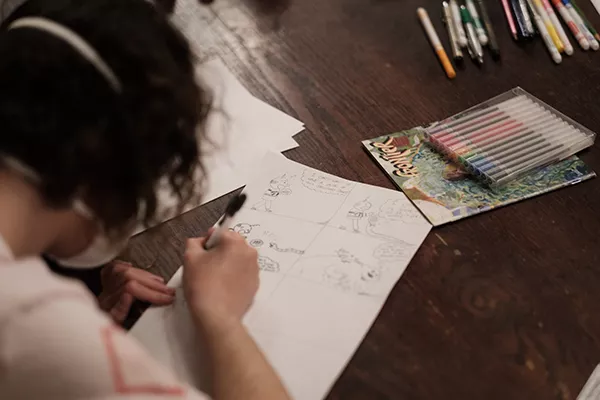Tillie Walden, who teaches at the Center for Cartoon Studies in White River Junction, Vt., and is the author of six books, and New Yorker cartoonist Emma Hunsinger recently worked with students enrolled in Advanced Readings in the Graphic Narrative, taught by Associate Professor of East Asian Studies Shiamin Kwa. The course is part of the 360° Constraints: Storytelling in the Digital Age.
“In the case of making comics we are limited by the constraints of the box-like forms of comics panels, groups of panels, and pages,” explains Kwa. “The thinking behind this class is that comics are a sophisticated and well-developed version of text-image hybrids, and learning to read them carefully and well is an essential skill because we are communicating in text-image form all the time now. Signage, advertisements, menus, and media of all kinds are no longer exclusively text-based, but use photographs, diagrams, illustrations, and animations to communicate their messages.”
Primary texts in the course include Lynda Barry’s The Freddie Stories and Emil Ferris’s My Favorite Thing is Monsters, alongside theoretical readings from literary and cultural theory, which students draw from to analyze how stories are told in image and text form.
In keeping with the philosophy that making is a way of thinking, Kwa asked the members of her class to participate in creating comics of their own to experience the constraints encountered by the people who make the books that they are studying every week.
"I have always enjoyed reading novels and comics,” says Annarose King ’23, an English major and student in the class. “This 360's focus on narrative, and incorporating what we learned into our own work, was really appealing for me. I have new insights about how an author creates emotional and visual depth in a graphic novel.”
Walden and Hunsinger led students through lectures on style, form, and character building, followed by exercises. Among the exercises was a challenge to draw random things (a car, Adam Driver, a ferret) in five minutes, then in two minutes, in 30 seconds, and finally five seconds. Other tasks included telling an adventure story using only stick figures; and drawing a two-page autobiographical story in the style of a randomly selected comics artist.
In addition to Kwa’s class, students in the 360° are also enrolled in Diasporic Voices: Voyages and Identity Narratives taught by Agnès Peysson-Zeiss, senior lecturer in French and Francophone Studies.
